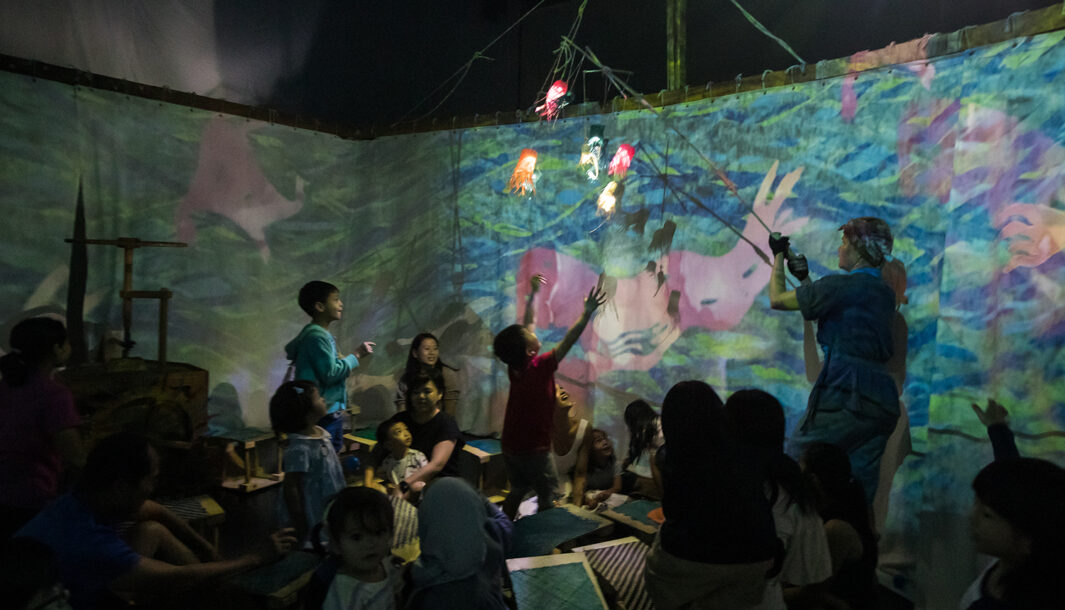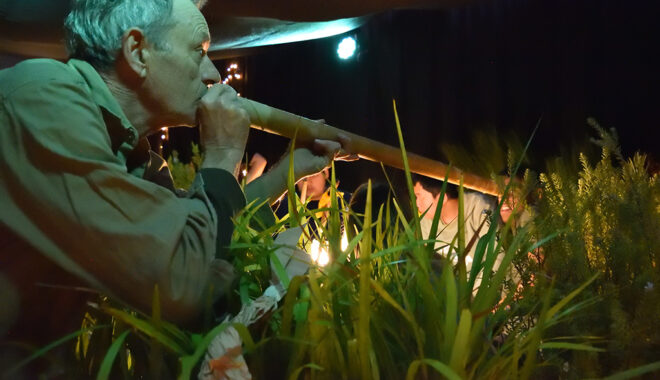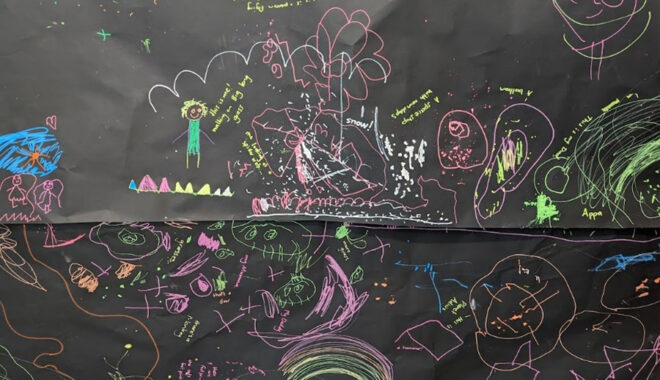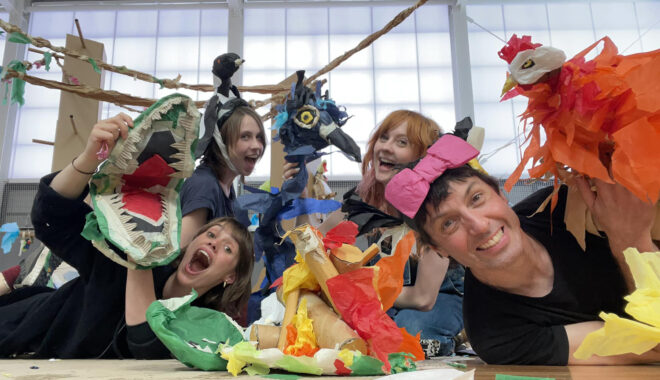22 Oct 2020 Education News
The Theatrical Frame

By Jennifer Andersen
I’ve always enjoyed performing in education settings. I like the proximity of the audience, and the intersection of everyday and imaginative spaces. I especially appreciate the small moments of transformation and wonder that occur during these experiences. One day, as my creative partner and I were setting up for a performance in a kindergarten, the teacher asked some children to help us clear away the classroom furniture. One boy eagerly joined in but soon looked crestfallen and confused as the teacher stopped him and explained that he was mistakenly removing bits of our set. As the show began, the class congregated in front of the performance area in buzzing little social groups – all except the accidental set-removalist who leant listlessly against the teacher, gently encircled by her arm. Then, something surprising happened. At the first gag of this slap-stick non-verbal comedy, the boy sat bolt upright and stared at his teacher with astonished delight. He then looked at the other laughing children with equal surprise and pleasure. He laughed so much throughout the performance that at one point he tipped over sideways.
As we were about to leave, we noticed a group of children were re-enacting and improvising on the physical humour in the play. The previously solitary child was making the others weak with laughter as he clowned around, revealing a gift for mimicry and comedy. ‘This is so good for him’ the teacher explained. ‘He’s just arrived in Australia and he’s desperate to fit in, but he doesn’t speak English yet, so it’s been hard for him to show people who he is.’
This incident has stuck with me over the years, but the way I’ve thought about it has changed. At first, I found it gratifying and touching; it’s always a pleasure to make children laugh and the experience reinforced my belief in the power of theatre to communicate across languages and cultures and to offer children alternative ways to express themselves. Recently, though, I’ve begun to think about this moment in terms of what it, and other theatrical experiences, can tell us about the capacities of children.
Iranian filmmaker Abbas Kiarostami said, ‘I’ve often noticed that we are not able to look at what we have in front of us unless it’s inside a frame.’ (Pulver, 2009) The experience described above offered a Kiarostami ‘frame’ with which to see this child more clearly as a creative and social being. It highlighted his delightful sense of humour, artful physical skills and ability to make meaning from new experiences. Perhaps more significantly, though, it showed how important it was for him to achieve a sense of belonging in an unfamiliar, complex and frequently baffling environment. From the moment we arrived, he was working overtime—as he must have been doing all day, every day—to understand and participate in what was occurring around him. What amazing courage and persistence he showed! The experience also reinforced that belonging or not-belonging isn’t an individual experience or responsibility; when one child doesn’t belong, none of the group truly do, because they need to be able to belong to one another (Davies, 2014; Paley, 1992). When given a theatrical key, this kindergarten group were freed from their awkward position of not knowing how to include one person and were all enhanced by the joy of knowing him more fully.
Once I started on this line of thinking, it ‘reframed’ how I thought about other theatrical experiences I’ve had with children. For example, when foyer chit chat segues into the first moments of a performance for babies, invariably a breathtaking stillness descends as the babies attune to the change in atmosphere. It is also common for parents of infants and toddlers to exclaim after a performance that they’ve never seen their children sit so quietly for so long. In these situations, we are able to witness very young children’s capacity for concentration, and understanding of mood, nuance and aesthetics because of the theatrical frame within which we are observing them. Polyglot took advantage of this phenomenon in their 2012 work for babies How High the Sky. In a nail-biting move, towards the end of the piece parents were led out of the performance space to observe their children from the periphery. From this new vantage point, parents were able to witness their babies as curious, focused, determined, calm, cheeky and sensorial theatrical participants. The babies were revealed as active agents who were, amusingly, rarely bothered by their parents’ absence.
What does this mean for adults, as theatre makers, educators, carers and parents? My doctoral research (Andersen, 2018; 2020) shows that apart from understanding children better— a valuable goal in itself—theatrical frames can help guide our artistic and pedagogical interactions with children. For example, the way children will invariably hover nearby as performers set up for a show in an early childhood centre highlights their intense curiosity and suggests that every moment of theatre incursions is significant to them. This has implications for everything from how performers enter the space to what post-performance discussions and explorations focus on. It may well be, for example, that the thematic content of the work is not significant to one group of children, but that their interest in seeing surprising materials being drawn out of boxes offers great potential for their own aesthetic explorations.
As the anecdote I began with describes, children will often glance at each other, their teachers and carers throughout the performance. Sometimes, one child’s verbal response can rapidly morph into a group chant. These behaviours demonstrate children’s impressive capacity to understand the world in relation to others and can inform how educators assess and plan for a group’s learning.
A theatrical frame for knowing children therefore asks these questions: How are the children understanding and responding to this experience? What does that reveal about their interests and capacities? How might we build on this? The answers can take children and adults alike in new and exciting directions.
Header photo: Alvin Ho, courtesy of Esplanade – Theatres on the Bay Singapore
References
Andersen, J. (2020). Understanding the artistry of actors who create theatre with and for children. Research in Drama Education: The Journal of Applied Theatre and Performance. Doi: 10.1080/13569783.2020.1779586
Andersen, J. (2018). Acting with care: How actor practice is shaped by creating theatre with and for children (Doctoral thesis). Available from http://hdl.handle.net/11343/208762
Davies, B. (2014). Listening to children: Being and becoming. Routledge.
Paley, V. G. (1992). You can’t say you can’t play. Harvard University Press.
Polyglot Theatre. (2020). How High the Sky.
Pulver, A. (2009). Abbas Kiarostami’s best shot. Guardian News and Media. https://www.theguardian.com/artanddesign/2009/jul/29/photography-abbas-kiarostami-best-shot
Biography
Jennifer is an actor, arts educator and researcher. She was co-founder (with Heidi Weatherald) of the children’s theatre company, Pocketfool, which specialised in creating theatre experiences with and for preschool aged children and has worked as a performer, director and dramaturg for numerous artworks involving young children and families. She was the coordinator of Artist Learning at ArtPlay SIGNAL for eight years, delivering programs to develop the capacity of artists to work with children and young people. Jennifer teaches drama and creativity at the Melbourne Graduate School of Education at the University of Melbourne and has worked and published on research projects there focused on actor practice, out-of-school arts education experiences and pedagogies, and narrative inquiry. Her doctoral research investigated how actor practice is shaped by creating theatre with and for children.
Connect with Jennifer on LinkedIn







